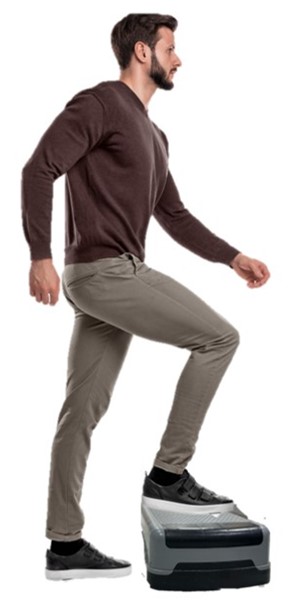The 3-minute step test can check on your cardio-pulmonary function, including exercise endurance, cardiorespiratory endurance, and cardiovascular function. The medical staff will monitor your physiological values at the same time, including heart rate, blood oxygen level, and blood pressure, which will be used as indicators in the exercise design and rehabilitation progress for your cardiopulmonary rehabilitation.
Target
- 20-65 years old, those without doctor recommendation not to exercise (including severe arrhythmia and severe rheumatoid arthritis), those without dizziness or unstable stance. Consult with your doctor or professional to check for the suitability in taking this test.
Procedures
- Wear comfortable and breathing clothes and sneakers.
- Put on the portable pulse oximeter, blood pressure and heart rate analyzer.
- On a 35cm step, step up and step down with a metronome set at 96 beats per minute for a stepping rate of 24 steps per minute (4 clicks = one step cycle). Continue the steps for 3 minutes.
- Measure the heart rates in 1 minute~ 1 minute and 30 seconds, 2 minutes ~ 2 minutes and 30 seconds, and 3 minutes ~ 3 minutes and 30 seconds, after exercise.
- To record: Plug all pulse rates into the following:
Fitness Index = Sustained Exercise Time (S) x 100
(Sum of three Pulses During Recovery Period) x 2
For fitness index, refer to the norms in the appendix.

Instructions During Test Procedures
Although the 3-minute step test is a safe and effective test, please pay close attention to the following conditions:
- Keep the legs straight when stepping up/down and keep it safe.
- You can change the foot stepping up midway but step down with the foot stepping up first. The stepping speed must conform with the beats.
- Do not jump on the step or step up/down on tiptoe only.
- No excessive eating and drinking before the test.
- Avoid staying up the night before and overwork the day before the test.
- Avoid excessive exercise 3 hours before the test.
- Stop immediately should any discomfort is experienced. For example, chest tightness, chest pain, out of breath, dizziness, breathing difficulty, cold sweat, and pale face.
- This test is unsuitable for those with lower extremity balance problem and lower extremity structural injury. For example, amputation, post lumbar vertebra surgery and acute ankle sprain.
3-Minute Step Test Scale Norm
|
Age (Years)
|
Sex
|
No Good
|
Poor
|
Average
|
Good
|
Very Good
|
||
|
20-24
|
Female
|
~46.6
|
46.7~50.6
|
50.7~54.2
|
54.3~59.6
|
59.7~
|
||
|
Male
|
~48.1
|
48.2~52.9
|
53.0~57.0
|
57.1~62.5
|
62.6~
|
|||
|
25-29
|
Female
|
~46.4
|
46.5~50.3
|
50.4~53.9
|
54.0~59.2
|
59.3~
|
||
|
Male
|
~47.1
|
47.2~51.1
|
51.2~55.2
|
55.3~60.8
|
60.9~
|
|||
|
30-34
|
Female
|
~46.9
|
47.0~51.1
|
51.2~54.9
|
55.0~60.4
|
60.5~
|
||
|
Male
|
~47.4
|
47.5~51.4
|
51.5~55.6
|
55.7~60.8
|
60.9~
|
|||
|
35-39
|
Female
|
~47.4
|
47.5~51.4
|
51.5~55.2
|
55.3~60.4
|
60.5~
|
||
|
Male
|
~47.6
|
47.7~52.0
|
52.1~55.9
|
56.0~61.2
|
61.3~
|
|||
|
40-44
|
Female
|
~47.1
|
47.2~52.0
|
52.1~55.6
|
55.7~60.8
|
60.9~
|
||
|
Male
|
~47.9
|
48.0~52.3
|
52.4~56.3
|
56.4~61.6
|
61.7~
|
|||
|
45-49
|
Female
|
~47.4
|
47.5~52.6
|
52.7~57.0
|
57.1~62.1
|
62.2~
|
||
|
Male
|
~48.1
|
48.2~52.9
|
53.0~57.0
|
57.1~62.5
|
62.6~
|
|||
|
50-54
|
Female
|
~47.1
|
47.2~53.3
|
53.4~57.7
|
57.8~63.4
|
63.5~
|
||
|
Male
|
~48.9
|
49.0~53.3
|
53.4~57.7
|
57.8~63.4
|
63.5~
|
|||
|
55-59
|
Female
|
~45.7
|
45.8~53.4
|
53.5~58.1
|
58.2~63.8
|
63.9~
|
||
|
Male
|
~48.9
|
49.0~53.9
|
54.0~58.8
|
58.9~64.3
|
64.4~
|
|||
|
60-64
|
Female
|
~41.4
|
41.5~50.8
|
50.9~57.0
|
57.1~63.4
|
63.5~
|
||
|
Male
|
~48.4
|
48.5~54.2
|
54.3~58.8
|
58.9~64.3
|
64.4~
|
|||

